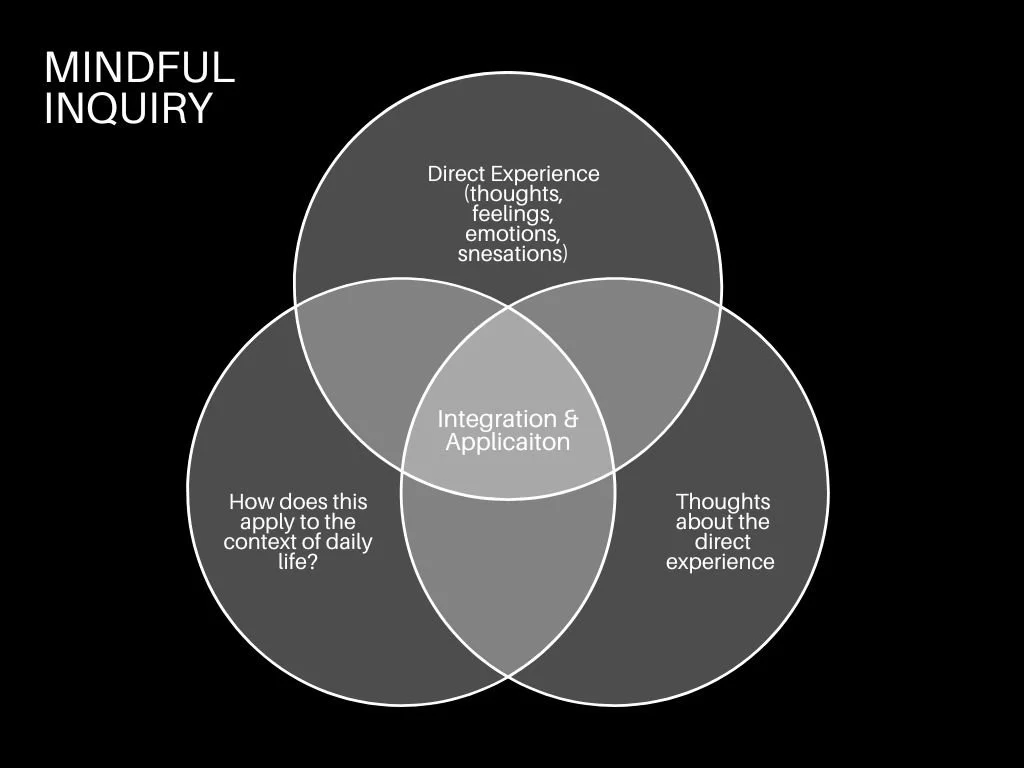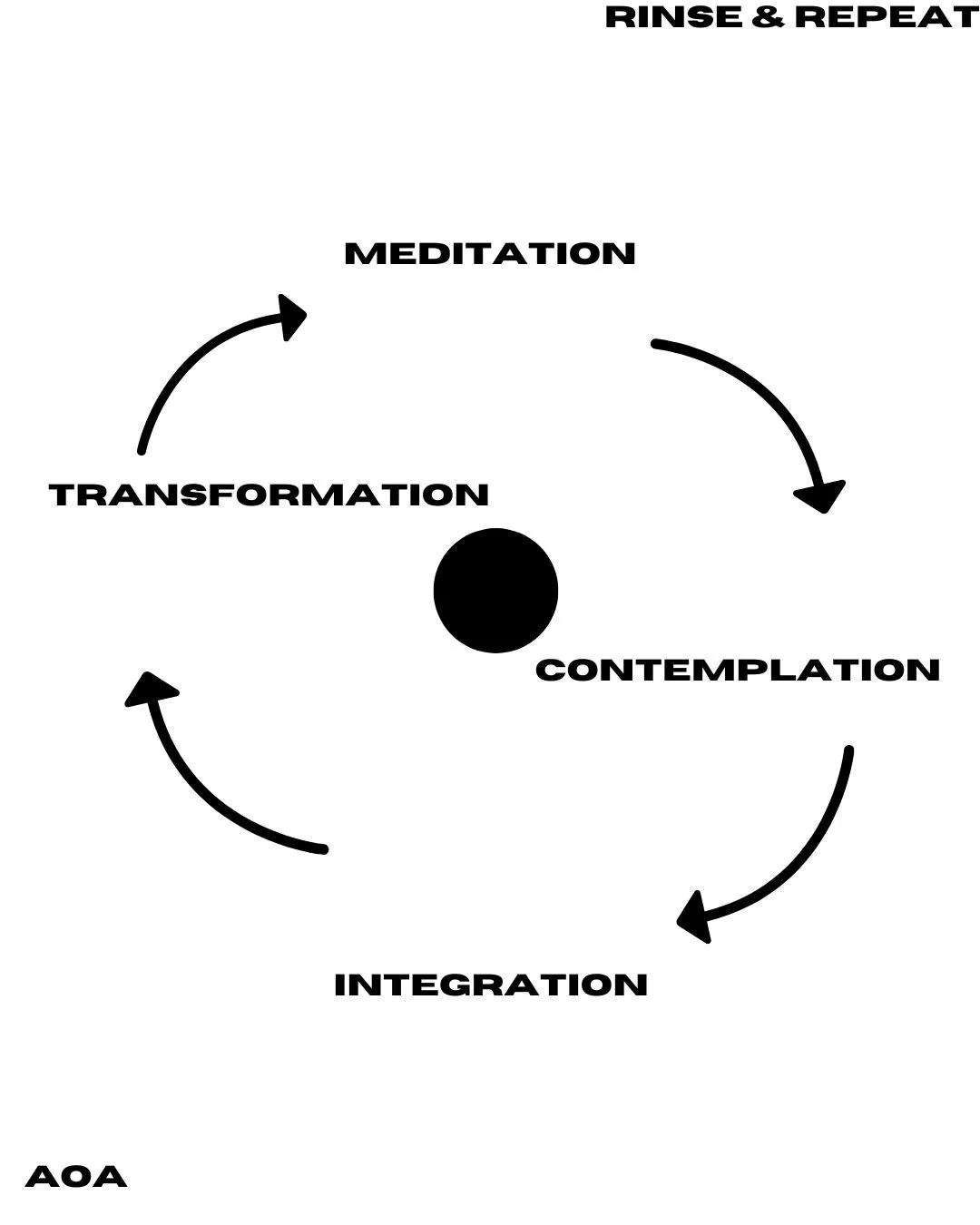Integration (3 of 4)
Following on from the previous post - ‘a simple framework for transformation’:
Meditation > Contemplation > Integration > Transformation
This is a brief on the third element.
Integration is where transformation becomes real - it’s bridging the gap between insight and way of being.
From potential to realisation.
I remember spending so much time consuming books, podcasts and talks on meditation and the brain, neuroplasticity, spirituality & inner work, self-improvement etc. for so long…
I was gaining more knowledge on these topics, more self-awareness - I was sitting around in meditation, paying attention and noticing my patterns, contemplating what I was noticing - but it was without taking the neccessary actions to make them part of me.
All these things remained concepts & theories - lessons waiting to be truly learnt.
The crux of integration is action - internalizing new behaviors, beliefs, and ways of being by doing them - so they become second nature. It’s the same process that we unconsciously undertook to get to this point.
It’s about aligning your daily actions with your newfound wisdom, this vision for who you want to be.
Without integration, transformation remains incomplete—it’s like planting seeds but not nurturing the soil and tending to the environment - never letting them take root.
Very quickly the weeds grow back.
During this phase, I remember countless times during my relationship with my ex-wife (Yvette) of 7 years, that I’d slip back into old patterns - particualrly triggered by her disdain for the relationship I have with my mother.
My bro and me were raised by her as a single parent since 4 & 5 (so you can imagine the attachment issues) and the Indian mother is well known to be over-bearing and overly mothering.
Yvette is 13 years my senior, closer to my mum’s age than mine - they didn’t get on…
I couldn’t see how I’d slip into “mummy’s boy” when around my mum, or how she could take advantage of that in order to get a ‘psychological win’ over the wife.
It caused a fair bit of conflict with me and Yvette, and it was painful because I knew I was avoiding facing up to my mum…
It was only after taking the action of having very uncomfortable and difficult conversations with my mother that I began to shift this pattern.
As my own man, not just my mum’s son. Our relationship is much more healthy now since then.
Went off on a tangent…but my point is the reverting back to old patterns when challenged - the familiar behaviours and thoughts. So this piece on taking actions is vital - they are the validation and evidence of the new person I was becoming.
A few points on working thru integration - an on-going process because there is always new experiences for us to learn from and make part of a new way of being….
Embodied Practice: making it part of you, not just in the mind - but moving, speaking, responding differently.
You will be tested in real-life situations.
Emotional Processing: Old wounds and patterns will resurface as you shift. Instead of avoiding them, they’re an opportunity to meet them in a new way, with awareness and compassion.
They are signs that you are growing - you wouldn’t be bothered if they come up otherwise.
Repetition & Consistency: Neural pathways are rewired through repeated action. Instead of "trying" to be confident by thinking it—we live with the confidence that comes with taking aligned action, until it becomes second nature.
This path comes with challenges, it seems the Universe throws up tests to ensure we are who we say we are - the attachment to this old version of you, clinging to who you were, will be resistance who you’re becoming.
What I’m seeing is that it is safe to let go, to shed these layers I’d accumulated that don’t serve me any longer.
True integration requires the committment to letting go of the old identity to allwo the new to really solidify. This requires a full, whole-hearted YES.
Next up the final part in this series: transformation. The cherry on the cake.
Let’s walk together.x
Arjun
Contemplation (2 of 4)
Following on from the previous post - ‘a simple framework for transformation’:
Meditation > Contemplation > Integration > Transformation
This is a brief on the second element.
This quote may come across provacative to some and harsh to others:
The unexamined life is not worth living - Socrates
Perhaps an overused quote, but perhaps not something nowadays we really put into action, at least as much as it was in ancient times.
There is serious value in witnessing one’s own experience - I feel this strongly as it is my experience in the process of transformation.
Meditation for me has been the path to really become intimate with myself, get up and close to thoughts, feelings, emotions…to learn about what drives me - why I do what I do.
I’ve said before, it’s been vital in the process of behaviour change, but it’s only the first part of the process…
…what perhaps is even more important is self-inquiry, reflection and contemplation in order to really acknowledge the direct experience during meditation, then make sense of it and ultimately then integrate and apply this to daily life.
This logical and objective investigation after meditation or some trigger or experience which affects you, is an aid to spiritual wisdom - one cannot gain wisdom without inquiry - you have an experience, it impacts you in some way - chemically, emotionally, mentally…but without the reflection and contemplation it soon becomes a distant memory.
Below is a sequence you can try after your meditation or after you’ve been triggered and you notice an internal shift:
(best employed with compassion and curiousity not condemnation or judgment)
What was the direct experience:
What thoughts, feelings, emotions showed up, how did they feel in the body. What was your reactions to what happened? What actually happened, in detail.
What are your thoughts about what happened:
What did you notice about your reactivity…reflect what you noticed about yourself during the experience. Are there any repeating patterns?
How does this apply to my daily life:
In the context of what I’m working on…does this move me closer to my vision or further away. How can I take action on what I am learning?
Contemplation requires a cool light - objectivity and (eventually) a diffusion of emotion…but to be able sit with and truly gain insight…one must first go into the heat and intensity of painful memories, the regret, or guilt, sadness or shame…and burn a little.
And know that this is the purification…the only stuff that burns away is impure, what’s left is the gold of spirit and the light of wisdom.
This is inner alchemy - take the pain and the wounds and turn into wisdom and a new way of being.
To meet these things about ourselves if challenging - this is why it’s not common to engage in, but in the process of transformation, it’s imperative to be released from them in order to create anew.
I’ve noticed that through this patient, consistent and committed practice of self-inquiry a lot of the charged emotion associated with my memories and traumatic experiences…eventually became discharged of the emotion….and Joe Dispenza says that “memory without emotional charge becomes wisdom.”
So through self-inquiry, cool contemplation...your own experience is your teacher. You are your own guru.
And as we begin to become free of this heavy baggage, we not only lighter - physically, emotionally and mentally - but also are beginning to open up space to being implementing new patterns of thought and action to intgegrate.
Now with purposeful intention in the direction we want to travel.
Next up in this series: integration. Taking action on what you are beginning to see.
Let’s walk together.x
Arjun
Meditation (1 0f 4)
Following on from the previous post - ‘a simple framework for transformation’:
Meditation > Contemplation > Integration > Transformation
This is a brief on the first element.
Years ago, an elderly gentleman, a stranger in a coffee shop, said to me: “you are only alive when you are meditating.” For context, I was reading a book on the topic and had a notebook out.
On the face of it, this sounds outlandish, maybe coming from the mouth of someone stoned or a Gandalf type, or both.
But switch the optics, and there is truth in this statement.
Meditation, amongst many things, is awareness of one’s experience - both inner & outer - eventually the practice develops the capacity to be with everything and anything that shows up.
Meditation enables one to be aware of the dynamic moment to moment experience of thought, feeling, emotion, sensation, sight, sound, smell, taste etc.
This old gent, I think meant, that when you are not aware of the fullness of your experience, you’re affectively walking dead.
How often are we preoccupied by only the ‘thought’ element of our experience - the constant stream of “I, me & mine”, so much so that everything else fades into the background until we’re forced to pay attention? i.e. some triggering event, challenging emotions, physical injury etc.
When we sit to meditate it can seem the mind is very busy, can’t get it to switch off or lots of challenging thoughts show up - this practice is not for me, or I’m doing it wrong, I can be doing something more productive etc.
This is not the fault of meditation and you ain’t doing it wrong, you’re simply seeing what the mind has been doing all along.
Without the usual daily stimuli and distraction - this is it.
You’re life - in this moment.
Acknowledge: you did not request for these things to arise, it was not your intention. You set the intention to focus on breathing or other sensations, and yet all the things still arise…
When you notice getting caught or lost in the mental activity, without judgement of the content or self-criticism you come back to your resting point i.e. the breath.
Over and over again. As you continue this process:
Focus > distraction > waking up > coming back to focus
You begin to recognise that you have a choice in whether or not you engage in what shows up in your experience. Remember, you didn’t intentionally request for these things to show up - so why take ownership or engage in it all?
New relationship to thought
And then in space you’ve created between stimulus and response, you reclaim control. And you begin to see patterns.
This is why I have this as the first element in the process of transformation.
Meditation is the clear lens into the nature of your mind, it’s tendencies, the dominant thought patterns, the stories you engage in, the judgments, the reactivity, the connection to the body (or lack of), the attachments etc.
Transformation cannot be acheived thru bypassing what is here right now (I’ve tried and I kept coming back to the same lesson in different forms until it was learnt) - every aspect of the self needs to be seen and felt in the mind & body - contemplated upon and then take steps to integrate it into a new way of being, on the way to transformation.
There’s so much more to explore within ourselves than we know, and we’re barely scratching the surface here.
Our minds have this incredible power of imagination & creation - which is the foundation for transformation and ultimately creating the lives we want to live from the purest & deepest part of ourselves.
We just need to clean house first so we can reclaim this power.
Let’s walk together.x
Arjun
Transformation: A Simple Framework
Leo da Vinci said: simplicity is the ultimate sophistication.
I do notice a sense of ease and a smoother entry into flow when there is more simplicity; less distraction & less choice brings more clarity and a willingness to let go of forced effort.
You’ll see the tabs of my site include the words:
Meditation | Contemplation | Integration | Transformation
I use these words a lot, think abut their meanings and the doorways they provide to access deeper aspects of myself. They are the spine of my work too, and when they came through in this way (picture below) - it felt aligned and definitive of the change process in my opinion and experience.
A stripped back visual interpretation of the on-going process of transformation - I love the simplicity of it.
Firstly, these are not far-away philosophical concepts, rather already innate human qualities and capabilities we possess, which only need to be exercised.
For example:
Meditation: You began paying attention to how you feel waking up because you don't like it.
Contemplation: You investigate: What could be causing it? It maybe because I eat really late?
Integration: You take action by experimenting with eating 2hrs earlier.
Transformation: Feeling energised upon waking so you begin to eat at a new dinner time.
When you engage in worry about the future - this is contemplation; when focusing fully on a work task - it’s a form of meditation and so on.
The key is to be an active particpant and intentionally use it for things that you want to.
The process naturally is not linear, shifting from one to the other in no particular order and we enage in these things all the time too whether we're aware of it or not.
There is potential to transform every moment, it does not have to be a life-long mission which the mind will make seem impossible to achieve.
This mechanism can be employed all the time and small steps compound.
Get into the practice of transformation in the seemingly small moments, and watch the bigger transformations take care of themselves.
Let’s walk together.x
Arjun




